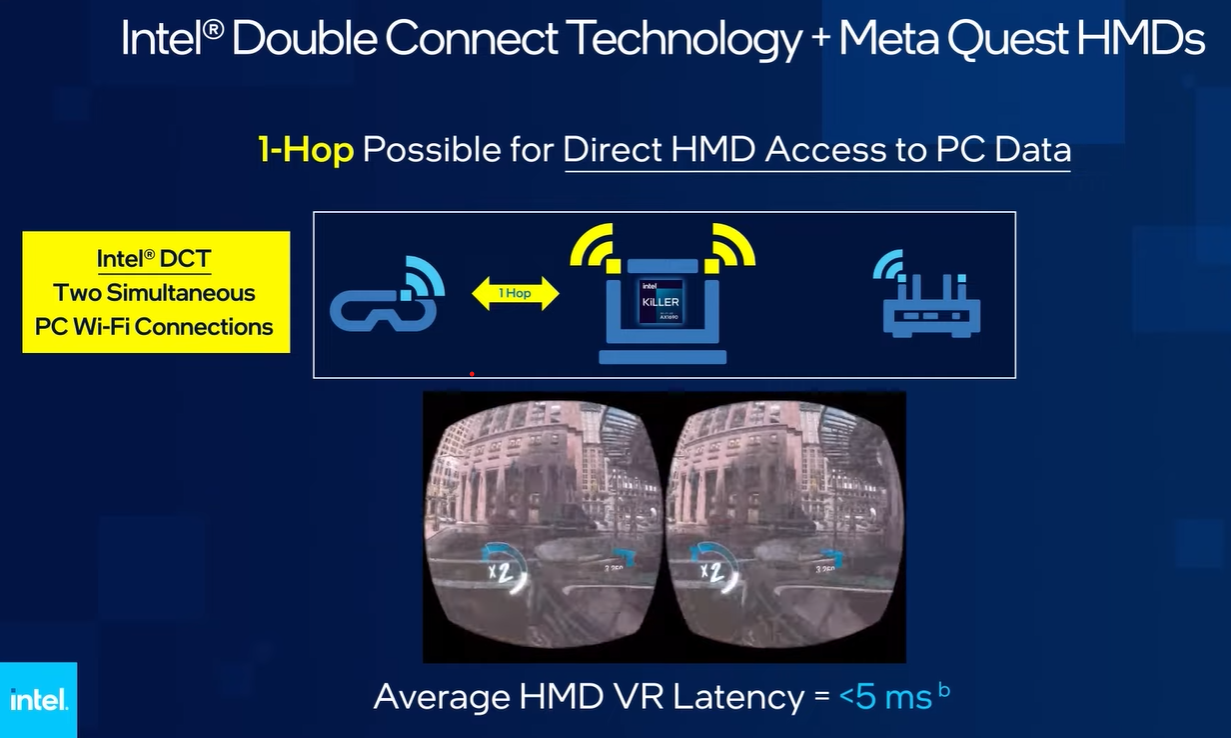Last Saturday, Intel partnered with immersive technology giant Meta to debut the AX1690 Wi-Fi chip, greatly enhancing the Quest portfolio’s streaming function.
Quest users can install the AX1690 Wi-Fi chip into a standard gaming PC setup. The component’s installation will allow users to stream PCVR titles directly to a Meta Quest device without relying on a WiFI router.
Previously, via the Quest’s AirLink PCVR steaming feature, the device’s wireless performance hinged massively on the user’s internet connection, which means that Meta Quest users would face low-latency connections during a streamed session.
Not only do low-latency connections interrupt a user’s performance and immersion; in casual, enterprise-grade, and training VR scenarios. But poor links during a VR experience can lead to inaccurate tracking, causing motion sickness in some users.
Although, thanks to Intel’s chipset innovation, users can now directly connect to a gaming PC as a “one-hop” procedure that skips connection to a router.

Intel is exclusively reserving its one-hop PCVR streaming features for the AX1690 Wi-Fi chip, with no word on future integration onto other chipsets.
AX1690 Wi-Fi: Powerful One-Step PCVR Streaming
To power the AX1690 Wi-Fi chip, Intel is leveraging its Double Connect Technology (DCT) system. The technology innovation enables gaming PCs to connect to 2.4GHz and 5GHz or 6GHz networks instantly.
Moreover, the Meta partnership allows Intel to leverage the DCT connectivity to connect Quest 2 and Pro devices (5GHz and 6HGz) directly to a PC. According to Intel, DCT-ready Quest devices offer up to 20 percent low latency connections.
In a promotional video by Intel, the firm showcased a test setup whereby the new chipset streamed the PCVR title Robo Recall to a Meta Quest device. The test utilised a Lenovo Legion 716 (82TD) device with an integrated 13th Gen Intel Core i7 processor and the featured AX1690 Wi-Fi chip.
The test revealed that Intel’s new solution could secure an average HMD VR latency of under 5MSb. In contrast, a conventional Airlink and WiFI router setup could ensure a Meta Quest user with latencies up to 30MSb.
Our data, which I think is likely the most definitive on the question at hand, suggests this would be an improvement for a meaningful percentage of Quest 2 consumers.
— Boz (@boztank) January 9, 2023
More on Airlink
Meta is actively supporting the Quest lineup with a native AirLink setup which secures users with PCVR streaming without any extra kit.
The AirLink feature relies on a Wi-Fi router to stream any PCVR title to the mobile VR headset portfolio.
The Quest streaming features open up the hardware’s content offerings massively by allowing users to include any PCVR software in their Meta Quest library.
Meta initially kept AirLink as an exclusive Quest 2 feature. Although with its V30 update last year, the firm introduced the streaming solution to the broader Quest lineup.
AirLink and Intel’s chip can significantly improve remote immersive collaboration and communication operations for enterprise clients.
When enterprise-grade VR software developers port a professional PCVR product to the Quest lineup, developers must downgrade elements like graphics to match the mobile device’s lower computing power.
The Meta Quest’s expanding streaming abilities give employees access to PCVR experiences with more features and improved visuals. Also, wireless connectivity helps businesses quickly set up and stream any collaboration software onto Quest devices.
Mobile VR headsets are an emerging trend in the extended reality (XR) landscape. For both consumer and enterprise end-users, XR hardware from vendors like RealWear, HTC VIVE, and Nreal all market a mobile experience that decreases reliance on heavy hardware while promoting lightweight devices that encourage user freedom of movement.
In an enterprise or industrial environment, firms use mobile XR hardware to stream content directly to a worker – ranging from training resources to video feeds.
Moreover, as real-time 3D (RT3D) graphics for XR applications become more sophisticated, some groups like NVIDIA are researching cloud streaming opportunities to instantly secure individuals with rich, immersive content.







